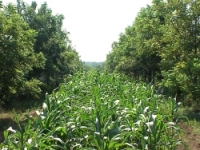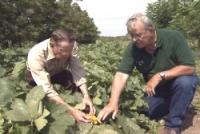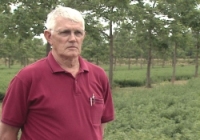Agroforestry Practices
Alley Cropping
Alley Cropping is planting rows of trees at wide spacings with a companion crop grown in the alleyways between the rows. Alley cropping can diversify farm income, improve crop production and provide protection and conservation benefits to crops. Common examples of alley cropping plantings include wheat, corn, soybeans or hay planted in between rows of black walnut or pecan trees. Non-traditional or value added crops may also be incorporated for extra income, including sunflowers or medicinal herbs planted in between rows of nut trees alternated with nursery stock trees. Fine hardwoods like walnut, oak, ash, and pecan are favored tree species in alley cropping systems and can potentially provide high value lumber or veneer logs while income is derived from a companion crop planted in the alleyways.
Alley Cropping Success Stories
Shepherd Farms, Clifton Hill, MO

|
| The landowner harvests annual crops of wheat and hay while the pecan trees mature. |
Dan Shepherd of Shepherd Farms, Clifton Hill, Mo., manages one of the state's most established pecan and wheat alley cropping practice examples, in addition to raising buffalo for processing into lean, high-quality meats and jerky. Shepherd Farms is also a nationwide leader in production, retail and wholesale distribution of Eastern Gamagrass. The farm has its own pecan cracking facility and a large country store, stocked with fresh pecans, snack mixes featuring the sweet nuts,

|
| Dan Shepherd of Clifton Hill, Mo., has utilized a successful alley cropping practice for several years, producing pecans for retail sale with wheat planted in the alleyways. |
"Alley cropping is ideal for achieving both our production and conservation benefits," said Shepherd. "We earn an annual income off the ground, while the trees are being established. We also enjoy an abundance of wildlife in the habitat created by alley cropping. While the crops are growing we see deer, turkey, quail, utilizing this ground and the trees."
 |
 |
 |
| Alley cropping is an attractive and efficient method for utilizing agricultural lands for both short and long-term income. | Corn can be alley cropped in between rows of black walnut. | Traditional or alternative crops can be incorporated into an alley cropping practice. |
Paul Smith
20-acre alley cropping practice
Northwest Missouri, near Claremont
"In 1999 we seeded this field to orchard grass and alfalfa. The first cutting this year produced about 3 ton per acre, and I feel that we benefit from the alley cropping because we have a short term benefit of the crops between the tree rows -- and eventually, my family or someone else will benefit from the tree crop."

|

|
| Paul Smith and his Black Walnut trees. | This northwest Missouri landowner has an established black walnut and alfalfa alley cropping practice. |
Learn more about alley cropping from the following UMCA resources, available for viewing or ordering from the Publications page:
- The Agroforestry 5-Practices DVD has a chapter featuring alley cropping, with successful Midwestern examples.
- The Training Manual for Applied Agroforestry Practices, available for viewing or ordering from the Publications page, contains a chapter about alley cropping and an information resources list.
- Read about Center for Agroforestry alley cropping research in the 2009 Research Highlights (PDF, 3.71 MB).

